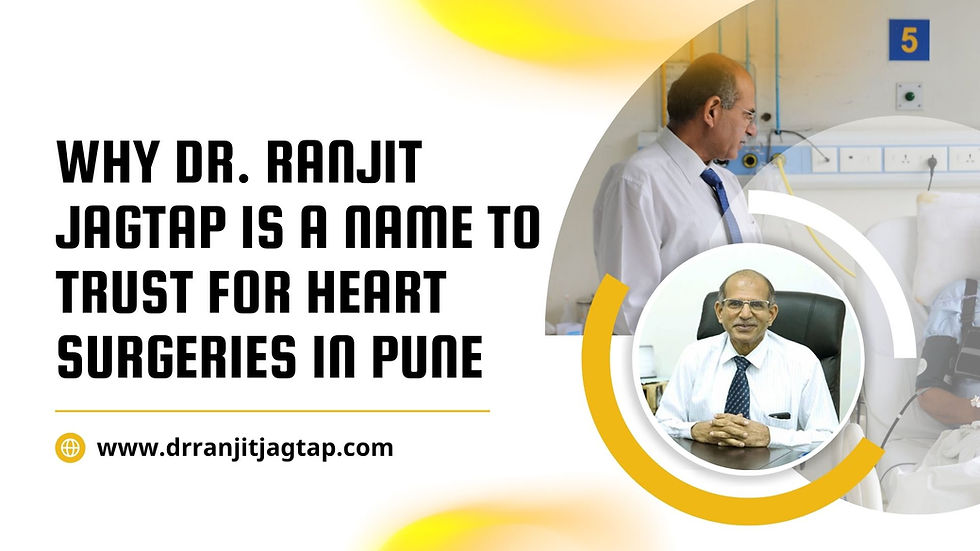Heart Rate vs. Blood Pressure: What You Need to Know - Dr. Ranjit Jagtap
- drranjitjagdap
- Dec 6, 2023
- 3 min read

Have you ever wondered how your heart ticks and why your blood feels the pressure? Well, that’s the right time to know the answer to this question as we discuss “Heart Rate vs. Blood Pressure.”
Let’s start with the heart rate, your heart’s rhythm, telling you how many beats it drums out in a minute. Heart rate is similar to your heart’s saying, “Everything is fine here,” according to Dr. Ranjit Jagtap.
Now, focus on blood pressure; it functions similarly to pipe water pressure. The Dr. Ranjit Jagtap Clinic highlights the significance of this. It all comes down to striking the ideal balance — neither too high nor too low, just right.
Heart rate and blood pressure are like partners in a dance inside your body. They complement one another, and Dr Ranjit Jagtap News frequently highlights this relationship. So, let’s untangle the stresses and beats and make health as simple as a Sunday morning conversation.
Heart Rate Demystified
Heart rate, in simple terms, is the number of times your heart beats per minute. It is a vital measure of your cardiovascular health. The heart, a powerful muscle, contracts and pumps blood throughout your body, delivering essential oxygen and nutrients to various organs and tissues. Monitoring your heart rate is a straightforward way to assess the efficiency of this crucial process.
An average resting heart rate for adults typically ranges between 60 to 100 beats per minute. Age, fitness level, and overall health can influence this rate. Regular physical activity lowers the resting heart rate, indicating a more efficient cardiovascular system.
Maintaining a healthy heart rate is essential for overall well-being. A consistently elevated heart rate may suggest underlying health issues, while an unusually low rate might also indicate potential concerns. Understanding and keeping track of your heart rate can be a valuable tool in assessing and maintaining your cardiovascular fitness.
Unveiling the Dynamics of Blood Pressure
Blood pressure is the force that your blood puts on the walls of your arteries as your heart pumps it around your body. It’s like the pressure in a water pipe, but in your circulatory system.
When you see blood pressure readings, they usually come in two numbers. The first one is the pressure when your heart contracts and pushes blood out (systolic), and the second is when your heart is at rest between beats (diastolic).
A regular blood pressure reading is around 120/80 mmHg. The first number (systolic) is your heart doing its pumping, and the second (diastolic) is when it’s chilling between beats.
Keeping an eye on your blood pressure is crucial because high blood pressure can strain your arteries and, over time, lead to serious health issues. It’s a bit like your heart telling you how well it’s handling its job of keeping your blood flowing smoothly.
The Interplay Between Heart Rate and Blood Pressure
Let’s talk about how your heart rate and blood pressure work together:
1. Heart Rate’s Beat:
Your heart rate is like a drumbeat, telling you how many times your heart dances in a minute. Dr. Ranjit Jagtap, a health expert often in the news, explains it. Think of it as your heart’s music, playing a big part in your body’s symphony.
2. Blood Pressure’s Push:
Now, blood pressure is like the force of blood against your blood vessels. Imagine it as the pressure in a water hose. Dr. Ranjit Jagtap Clinic says it’s vital, like traffic flow in your body’s highways.
3. Systolic and Diastolic Duo:
Breaking it down, when your heart beats, it creates a power surge called systolic pressure. It’s like a car speeding up on the highway. In between beats, there’s a baseline pressure — diastolic pressure — like the calm traffic when the road is quiet.
4. The Harmony:
Now, here’s the magic — they work together. Your heart rate sets the pace, and blood pressure pushes the blood through your vessels. They’re like dance partners in your body’s groove. Dr. Ranjit Jagtap News discusses this connection, explaining how it’s crucial for your health.
A tip from Dr. Ranjit Jagtap’s family — his daughter, Aditi Jagtap Pune. Understanding this dance is like learning the steps to a healthy dance. It’s not just about beats; it’s about the force creating a healthy symphony.
So, when your heart’s beating, and your blood pressure is smooth, it’s like a perfectly choreographed dance. Stay tuned for more insights from Dr Ranjit Jagtap’s daughter and his family, guiding us through the dance of health — where heart rate and blood pressure take the lead.
Conclusion:
To summarise, understanding the finer points of blood pressure and heart rate is essential to keeping the cardiovascular system in good working order. You give yourself the power to live a heart-healthy life by remaining informed and adopting preventative measures.
Remember that the blood pressure and heart rate are not just numbers; they are the harmony of your health. Assume responsibility, maintain awareness, and allow your heart to beat in sync with a healthy life.





Comments